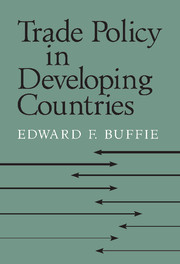Book contents
- Frontmatter
- Contents
- 1 Introduction
- 2 Tools and Tricks of the Trade, Part I: Duality Theory
- 3 The Trade Policy Debate
- 4 Tools and Tricks of the Trade, Part II: Linear Differential Equations and Dynamic Optimization
- 5 Underemployment, Underinvestment, and Optimal Trade Policy
- 6 Liberalization and the Transition Problem, Part I: Transitory Unemployment
- 7 Tools and Tricks of the Trade, Part III: The Dynamics of Temporary Shocks
- 8 Liberalization and the Transition Problem, Part II: Credibility and the Balance of Payments
- 9 Direct Foreign Investment, Economic Development, and Welfare
- 10 Suggestions for Future Research
- References
- Index
6 - Liberalization and the Transition Problem, Part I: Transitory Unemployment
Published online by Cambridge University Press: 29 July 2009
- Frontmatter
- Contents
- 1 Introduction
- 2 Tools and Tricks of the Trade, Part I: Duality Theory
- 3 The Trade Policy Debate
- 4 Tools and Tricks of the Trade, Part II: Linear Differential Equations and Dynamic Optimization
- 5 Underemployment, Underinvestment, and Optimal Trade Policy
- 6 Liberalization and the Transition Problem, Part I: Transitory Unemployment
- 7 Tools and Tricks of the Trade, Part III: The Dynamics of Temporary Shocks
- 8 Liberalization and the Transition Problem, Part II: Credibility and the Balance of Payments
- 9 Direct Foreign Investment, Economic Development, and Welfare
- 10 Suggestions for Future Research
- References
- Index
Summary
The results in Chapter 5 argue that most LDCs pursued excessively protectionist policies in the recent past. This conclusion agrees with conventional wisdom, but it does not, on its own, justify aggressive trade liberalization. Attempts to reduce protection to more moderate, sensible levels have been neither easy to sustain nor clearly welfare-improving. While some liberalization programs have worked well, many others have confirmed policy makers' worst fears that lower trade barriers will increase unemployment and worsen the balance of payments deficit. Prior to the nineties, one or both of these problems often provoked a reversal of the trade reform after a fairly short period of time. The NBER project organized by Bhagwati and Krueger examined 22 liberalization episodes in the pre-1980 period; in 16 of the 22 episodes, the attempt at reform was abandoned within five years. A more recent World Bank study (Michaely, Papageorgiou, and Choksi, 1991) reports similarly discouraging figures. The study was confined to liberalization attempts outside of Sub-Saharan Africa that lasted at least two years, which undoubtedly skewed the sample toward successful outcomes. Nevertheless, the failure rate was 64% overall and 83% for first attempts to liberalize severely distorted trade regimes.
There are two important aspects to the liberalization problem. The first is the problem of making the transition – the problem of how to get from here to there. The second concerns the extent to which adjustment costs matter for the welfare arithmetic.
- Type
- Chapter
- Information
- Trade Policy in Developing Countries , pp. 187 - 232Publisher: Cambridge University PressPrint publication year: 2001



